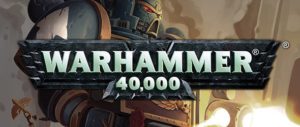
Greetings unaugmented humanity! Magos Geologis here again, this time to begin to delve into Fantasy Flight Games’ Deathwatch roleplaying game, and by extension, their Warhammer 40,000 (40k) line. Games Workshop has recently released a whole set of new models for the Deathwatch so now is a great time to take a look at the game. But first, let us lay a proper foundation and answer the question; what is Warhammer 40,000?
The first and most basic answer to this question comes from a tag line often used in the game; “In the grim darkness of the far future there is only war.” This provides an accurate summary of the primary features of the setting which we will examine in turn.
The Far Future
 40k is set in and around the year 40,000. In the time between then and now humanity spread across the stars and unlocked many of the secrets of the universe. Incredible technologies were discovered and amazing machines constructed. But humanity reached too far, too fast, and disaster struck. Terrible weapons were unleashed, the scourge of artificial intelligence reared its head, alien (xenos) threats destroyed entire cultures, and civilization collapsed. After much time the Imperium, led by one called the Emperor, emerged from the ashes, spreading out from Holy Terra (Earth) to reunite the lost worlds of humanity and conquer the galaxy. Much knowledge had been lost, but this was a golden age of rediscovery until vile betrayal and treachery shattered the Emperor’s dream. The Warmaster Horus, one of the Emperor’s favoured sons (called a Primarch), turned on his father and led half of his brothers, along with their armies, in rebellion. The Horus Heresy tore the galaxy asunder, pitting brother against brother and destroying much of humanity’s newly regained knowledge. The Heresy ended with the death of Horus and the crippling of the Emperor. His mortal form dying, the Emperor was interred in the Golden Throne. Ten thousand years have passed since that day and the Imperium is a shadow of that glory. Nonetheless it endures, watched over by the now God-Emperor, who rules from the Golden Throne on Terra and holds back the endless foes of humanity by the might of His inexhaustible armies.
40k is set in and around the year 40,000. In the time between then and now humanity spread across the stars and unlocked many of the secrets of the universe. Incredible technologies were discovered and amazing machines constructed. But humanity reached too far, too fast, and disaster struck. Terrible weapons were unleashed, the scourge of artificial intelligence reared its head, alien (xenos) threats destroyed entire cultures, and civilization collapsed. After much time the Imperium, led by one called the Emperor, emerged from the ashes, spreading out from Holy Terra (Earth) to reunite the lost worlds of humanity and conquer the galaxy. Much knowledge had been lost, but this was a golden age of rediscovery until vile betrayal and treachery shattered the Emperor’s dream. The Warmaster Horus, one of the Emperor’s favoured sons (called a Primarch), turned on his father and led half of his brothers, along with their armies, in rebellion. The Horus Heresy tore the galaxy asunder, pitting brother against brother and destroying much of humanity’s newly regained knowledge. The Heresy ended with the death of Horus and the crippling of the Emperor. His mortal form dying, the Emperor was interred in the Golden Throne. Ten thousand years have passed since that day and the Imperium is a shadow of that glory. Nonetheless it endures, watched over by the now God-Emperor, who rules from the Golden Throne on Terra and holds back the endless foes of humanity by the might of His inexhaustible armies.
Grim Darkness
There are no “good guys” in 40k. There are heroes and there are villains. Beings perform acts of valour, bravery, and self-sacrifice every day, but none of the great factions is really “good.” The Imperium is a fascist empire that has stripped all rights from the individual and justifies atrocities in the name of its God-Emperor. The Orks seek nothing but the joy of war and slaughter. The Tyranids are all consuming, stripping all bio-mass from a world before moving on. The Eldar are the remnants of an ancient race who’s glory days are long past and will kill thousands of the “lesser races” if it increase the probability that one Eldar life might be spared. The Dark Eldar are a perversion of the Eldar who sustain themselves with the agonies of others. The Tau promote the “Greater Good” but mercilessly crush any who refuse to submit to their rule. The Necrons are an awakening race who seek to reclaim a galaxy that has changed over their millennia of sleep. The forces of Chaos seek to shatter the veil between reality and the madness of the Warp. No faction can claim the absolute moral high ground, though some are more evil than others.
Only War
There is no peace in 40k. Alliances between races, if they exist at all, are fleeting, usually only lasting until a greater threat is defeated. There is no room for weakness in the battle for survival, no room for mercy, or understanding. Anyone who is not with you is an enemy you must crush utterly, lest they destroy you. An apt statement that summarizes the Imperium’s attitude towards all that are not part of it; “The enemy of my enemy dies next.”
So what is the draw of 40k then? It is a setting that combines fantasy and science fiction with reckless abandon. Massive armoured battle tanks race into battle carrying men armed with swords. Enormous engines of war duel with weapons that can annihilate city blocks while on the ground champions duel to the death. Beings able to access the deadly energies of the Warp with their minds (Psykers) hurl blasts of flame and lightning while superhuman warriors in towering suits of armour teleport into the midst of the enemy to crush them with hammers. 40k is a sandbox of enormous potential, with room to tell all manner of stories. It has room for discovery; so much technology has been lost that wondrous artifacts are always available to serve as plot hooks. There is room for horror; the madness of the Warp, the creeping horror of a stalking Genestealer, or the deprivations of the Dark Eldar can all invoke this theme. Mad science; the Adeptus Mechanicus operates its machines through prayer and by anointing them with oils while chanting specific phrases. Investigation; Inquisitors and their acolytes must be ever vigilant in rooting out cults on Imperial worlds. There is no limit to what you can do in 40k.
Hopefully this overview has drawn your interest and explained the basics of the setting of Warhammer 40 000 to the uninitiated. Fantasy Flight Games publishes five separate role playing lines in this setting, each delving into a different aspect. Next time I will continue to explore the third line that was released, Deathwatch, by examining what the Deathwatch is and why this is such a fun and interesting role playing game. Later on I will delve into various aspects of 40k lore; the races, the technology, etc. If you are interested in learning more about these systems from FFG or already play then a fantastic resource is the Grim Dark Podcast on this very network, d20 Radio. James and Mike are excellent hosts and do a great job exploring different aspects of the various games in each show. Until next time remember; Knowledge is Power, Guard it well.
Eamon Duffy
Latest posts by Eamon Duffy (see all)
- The Cursed Town - October 28, 2016
